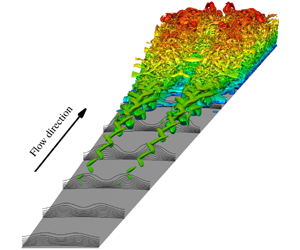Crossref Citations
This article has been cited by the following publications. This list is generated based on data provided by
Crossref.
Dong, Siwei
Chen, Jianqiang
Yuan, Xianxu
Chen, Xi
and
Xu, Guoliang
2020.
Wall pressure beneath a transitional hypersonic boundary layer over an inclined straight circular cone.
Advances in Aerodynamics,
Vol. 2,
Issue. 1,
Paredes, Pedro
Venkatachari, Balaji
Choudhari, Meelan M.
Li, Fei
Chang, Chau-Lyan
Zafar, Muhammad I.
and
Xiao, Heng
2020.
Toward a Practical Method for Hypersonic Transition Prediction Based on Stability Correlations.
AIAA Journal,
Vol. 58,
Issue. 10,
p.
4475.
Zhang, Chuanhong
2020.
Evolution of the second mode in a hypersonic boundary layer.
Physics of Fluids,
Vol. 32,
Issue. 12,
Paredes, Pedro
Scholten, Anton
Choudhari, Meelan M.
and
Li, Fei
2021.
Hypersonic Boundary-Layer Transition on Blunted Cones at Angle of Attack.
Goparaju, Hemanth
Unnikrishnan, S.
and
Gaitonde, Datta V.
2021.
Effects of Nose Bluntness on Hypersonic Boundary-Layer Receptivity and Stability.
Journal of Spacecraft and Rockets,
Vol. 58,
Issue. 3,
p.
668.
Ma, Shaoxian
Duan, Yi
Huang, Zhangfeng
and
Yao, Shiyong
2021.
Improved nonlinear parabolized stability equations approach for hypersonic boundary layers*
.
Chinese Physics B,
Vol. 30,
Issue. 5,
p.
054701.
Goparaju, Hemanth
and
Gaitonde, Datta
2021.
Receptivity and instability of entropy-layer disturbances in blunted plate transition.
Hartman, Andrew
Hader, Christoph
and
Fasel, Hermann F.
2021.
Direct Numerical Simulations of laminar-turbulent boundary-layer transition for a blunt cone at Mach 6.
Ma, Shaoxian
and
Huang, Zhangfeng
2021.
Nonlinear interaction between two second-mode disturbances with the same frequency in a hypersonic boundary layer over a swept blunt plate.
Physics of Fluids,
Vol. 33,
Issue. 4,
Chen, Jianqiang
Yi, Shihe
Li, Xinliang
Han, Guilai
Zhang, Yifeng
Yang, Qiang
and
Yuan, Xianxu
2021.
Theoretical, numerical and experimental study of hypersonic boundary layer transition: Blunt circular cone.
Applied Thermal Engineering,
Vol. 194,
Issue. ,
p.
116931.
Hartman, Andrew
Hader, Christoph
and
Fasel, Hermann F.
2021.
Direct Numerical Simulations of laminar-turbulent boundary-layer transition for blunt cones at Mach 6: Effect of Varying Nose Bluntness.
Zhang, Chuanhong
and
Shi, Zhiwei
2021.
Nonlinear interactions in a hypersonic boundary layer.
AIP Advances,
Vol. 11,
Issue. 3,
Beyak, Ethan S.
Groot, Koen J.
Riha, Andrew K.
Patel, Jay M.
Coder, James G.
and
Reed, Helen L.
2022.
Nonlinear Boundary-Layer Stability Analysis of a Swept, Natural-Laminar-Flow Airfoil.
Kennedy, Richard E.
Jewell, Joseph S.
Paredes, Pedro
and
Laurence, Stuart J.
2022.
Characterization of instability mechanisms on sharp and blunt slender cones at Mach 6.
Journal of Fluid Mechanics,
Vol. 936,
Issue. ,
Estruch-Samper, David
Hillier, Richard
and
Vanstone, Leon
2022.
Turbulent spot transit of a hypersonic laminar separation.
Journal of Fluid Mechanics,
Vol. 935,
Issue. ,
Scholten, Anton
Paredes, Pedro
Hill, Jonathan L.
Borg, Matthew P.
Jewell, Joseph S.
and
Choudhari, Meelan M.
2022.
Hypersonic Boundary-Layer Instabilities over Ogive-Cylinder Models.
Massa, L.
2022.
Multiresolution Reconstruction of the Hypersonic Heat Flux.
International Journal of Heat and Mass Transfer,
Vol. 190,
Issue. ,
p.
122772.
Xu, Xiwang
Yi, Shihe
Han, Junhao
Quan, Pengcheng
and
Zheng, Wenpeng
2022.
Effects of steps on the hypersonic boundary layer transition over a cone at 10° angle-of-attack.
Physics of Fluids,
Vol. 34,
Issue. 3,
Scholten, Anton
Goparaju, Hemanth
Gaitonde, Datta V.
Paredes, Pedro
Choudhari, Meelan M.
and
Li, Fei
2022.
Linear Disturbance Amplification Over Blunted Flat Plates in High-Speed Flows.
Goparaju, Hemanth
and
Gaitonde, Datta V.
2022.
Role of entropic instabilities in laminar-turbulent transition on a blunted flat plate.
Physical Review Fluids,
Vol. 7,
Issue. 10,
